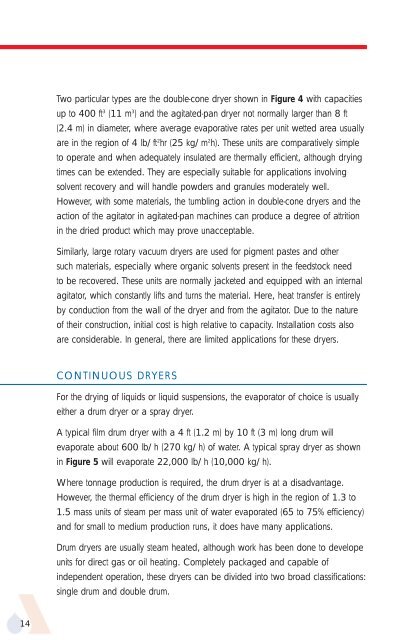APV Dryer Handbook - Umbc
APV Dryer Handbook - Umbc
APV Dryer Handbook - Umbc
You also want an ePaper? Increase the reach of your titles
YUMPU automatically turns print PDFs into web optimized ePapers that Google loves.
14<br />
Two particular types are the double-cone dryer shown in Figure 4 with capacities<br />
up to 400 ft3 (11 m3 ) and the agitated-pan dryer not normally larger than 8 ft<br />
(2.4 m) in diameter, where average evaporative rates per unit wetted area usually<br />
are in the region of 4 lb/ft2hr (25 kg/m2h). These units are comparatively simple<br />
to operate and when adequately insulated are thermally efficient, although drying<br />
times can be extended. They are especially suitable for applications involving<br />
solvent recovery and will handle powders and granules moderately well.<br />
However, with some materials, the tumbling action in double-cone dryers and the<br />
action of the agitator in agitated-pan machines can produce a degree of attrition<br />
in the dried product which may prove unacceptable.<br />
Similarly, large rotary vacuum dryers are used for pigment pastes and other<br />
such materials, especially where organic solvents present in the feedstock need<br />
to be recovered. These units are normally jacketed and equipped with an internal<br />
agitator, which constantly lifts and turns the material. Here, heat transfer is entirely<br />
by conduction from the wall of the dryer and from the agitator. Due to the nature<br />
of their construction, initial cost is high relative to capacity. Installation costs also<br />
are considerable. In general, there are limited applications for these dryers.<br />
CONTINUOUS DRYERS<br />
For the drying of liquids or liquid suspensions, the evaporator of choice is usually<br />
either a drum dryer or a spray dryer.<br />
A typical film drum dryer with a 4 ft (1.2 m) by 10 ft (3 m) long drum will<br />
evaporate about 600 lb/h (270 kg/h) of water. A typical spray dryer as shown<br />
in Figure 5 will evaporate 22,000 lb/h (10,000 kg/h).<br />
Where tonnage production is required, the drum dryer is at a disadvantage.<br />
However, the thermal efficiency of the drum dryer is high in the region of 1.3 to<br />
1.5 mass units of steam per mass unit of water evaporated (65 to 75% efficiency)<br />
and for small to medium production runs, it does have many applications.<br />
Drum dryers are usually steam heated, although work has been done to develope<br />
units for direct gas or oil heating. Completely packaged and capable of<br />
independent operation, these dryers can be divided into two broad classifications:<br />
single drum and double drum.











